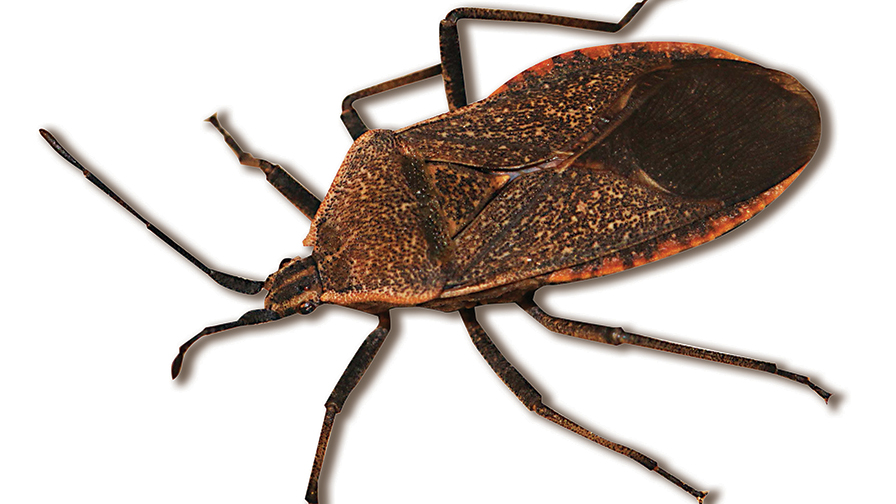Field Scouting Guide: Squash Bug
 This edition of “Field Scouting Guide” concentrates on Anasa tristis (squash bug).
This edition of “Field Scouting Guide” concentrates on Anasa tristis (squash bug).
Our expert for this installment is Thomas P. Kuhar, a Professor and Extension Vegetable Entomology Specialist at Virginia Tech University.
Kuhar was kind enough to share papers he authored with his students on the subject. Some of the information below comes from Squash Bug (Hemiptera: Coreidae): Biology and Management in Cucurbitaceous Crops (by H. B. Doughty, J. M. Wilson, P. B. Schultz, and T. P. Kuhar).
Basics
- Scientific name: Anasa tristis
- Common name: Squash bug
- Geographical Range: Squash bug is endemic to North America.
- Crops affected: The pest primarily wreaks havoc on cucurbits like squash and pumpkin (especially summer squash), but it may attack other cucurbits as well. This pest causes wilt in plants by piercing the plant and transmitting Serratia marcescens, a pathogenic bacteria species that causes cucurbit yellow vine decline.
Pest Impact
Kuhar: Squash bug is an important pest of squash and pumpkin in Virginia almost every year and can be found on other cucurbit crops. Some years are worse than others, and organic farms tend to have bigger pest problems. If not controlled, this pest often can build up high numbers and contribute to the decline of cucurbit crops in late season. On a positive note, the parasitoid wasp, Gryon pennsylvanicum, keeps pest populations in check in the higher elevations and in cooler climates. The parasitoid does not do as well in hotter environments.
Identification

Squash bug nymphs are quite conspicuous on the undersides of leaves, indicating their involvement in the wilt problem. Photos by Thomas Kuhar and his students at Virginia Tech.
Kuhar: Feeding by squash bug kills the plant cells, which leads to wilting symptoms called “Anasa wilt.” This symptom can be confused with other problems, but typically, nymphs are quite conspicuous on the undersides of leaves, indicating their involvement in the wilt problem. The disease yellow vine decline, which is a bacterial pathogen transmitted by squash bug, is a bigger problem in the central U.S. It has appeared once or twice in Western Virginia.
Traditional Treatment
“Chemical control is the most widely used strategy to prevent crop damage from squash bug. Insecticides are often applied to target the nymphal stage, which is easier to kill than adults. Effective control of squash bug nymphs can be achieved with foliar applications of pyrethroids such as bifenthrin, cypermethrin, fenpropathrin, lambda-cyhalothrin, and others, as well as neonicotinoids such as thiamethoxam, imidacloprid, clothianidin, acetamiprid, and organophosphates, such as disulfoton and metasystox-R,” Kuhar and the rest of his team wrote in their paper.
Organic Treatment
The paper adds that organic cucurbits production can be more difficult to protect because weedy ground cover, straw mulch, and other common materials in the organic farm habitat are conducive to squash bug infestations. In this case, growers should use the following cultural practices:
- Use proper field sanitation to remove old squash plants and other debris from the growing area.
- Plant early to help reduce infestation levels.
- Eliminate host plants on the farm through the use of proper crop rotation.
Biological Treatment
“Squash bug eggs, nymphs, and adults are attacked by various generalist predators such as spiders, carabids, staphilinids, geocorids, and coccinellids, all of which contribute to lowering population levels. Predation of squash bugs may be increased by employing farmscaping strategies that conserve predators. But, the most important natural enemies of squash bug are parasitoids,” the paper says.
This is where the Gryon pennsylvanicum, a parasitoid wasp and natural squash bug enemy, can help growers protect their crops. For more information, read A Survey of the Species of Squash Bug (Hemiptera: Coreidae) Egg Parasitoids in Virginia and Their Distribution.
Blended Control Approach
Overall, the paper recommends a mixed approach.
“For conventional growers today, a number of insecticides, particularly pyrethroids and neonicotinoids, are registered that provide effective control of the pest. However, these insecticides pose risks to nontarget organisms such as natural enemies and pollinators and are not the most IPM-compatible control options.
“A combination of preventative and curative control measures discussed above provide a number of options to effectively manage this pest using an IPM approach. A greater focus on scouting for the pest before applying pesticides, awareness and conservation of natural enemies in the agro-ecosystem, and use of more selective narrow-spectrum insecticides, if and when they are needed, would provide a more sustainable approach to managing this pest.”










